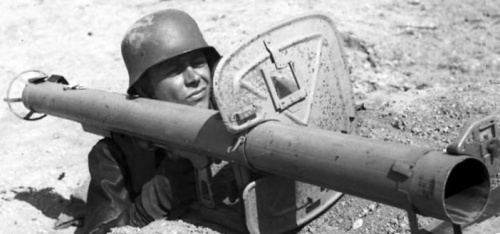
RPzB.43 Ofenrohr antitank rocket launcher with its rocket

RPzB.54 Panzerschreck antitank rocket launcher
German soldier firing RPzB.43 Ofenrohr antitank rocket launcher; note gas mask necessary to protect shooter's face from rocket backblast

German soldier firing RPzB.54 Panzerschreck antitank rocket launcher
|
Caliber |
88 mm |
|
Type |
Rocket launcher |
|
Overall length |
1400mm |
|
Weight |
9.5 kg empty (RPzB.43) |
|
Max. effective range |
~150 meters |
|
Armor penetration |
210 mm / 90o |
The Raketenpanzerbüchse 43 (RPzB.43 in short, translated from German as “Rocket antitank rifle [model of] 43”) was designed during 1943 in Germany as an answer to American M1 Bazooka antitank rocket launcher. It was designed by HASAG company, and put into production by late 1943. Officially designated as RPzB.43, this highly effective weapon quickly earned nickname “Ofenrohr” (Stove pipe). Following initial field experience, it was modified with introduction of the protective shield for the shooter and an improved, more elaborate sight, and adopted late in summer of 1944 as RPzB.54 “Panzerschreck” (“tank terror”). Before the war ended, German army possessed more than 100 000 of RPzB.43 Offenrohr and RPzB.54 Panzerschreck rocket launchers, which inflicted serious damage to many allied tanks. Compared to US M1 and M9 Bazooka rocket launchers and British PIAT, Ofenrohr and Panzerschreck provided slightly longer effective range and noticeably better armor penetration (mostly due to the warhead of larger diameter and weight). On the other hand, German 88mm rocket launchers were noticeably heavier than its American rivals, and created large dangerous backblast zone when fired – bad feature not found in the British PIAT.
The RPzB.43 Ofenrohr rocket launcher primary projectile type was the RPzB.GR.4322 – solid fuel rocket with HEAT warhead. It weighted about 3.3 kg and achieved muzzle velocity of about 110 m/s. Motor ignition was achieved by means of electricity. In flight rockets were stabilized by radial tail fins. Rocket motor normally continued to burn for some time after rocket left the muzzle, subjecting the shooter to the dangerous blast of hot powder gases and dense smoke. Therefore, Offenrohr operators had to use gas masks and protective gloves to avoid burns from rocket backblast.
The RPzB.43 Ofenrohr anti tank rocket launcher utilized smoothbore barrel, made from steel tube and opened at both ends. Rockets are loaded into the barrel from the rear. After loading, rocket has to be connected to the electric firing system by its own wires, which are inserted into the jack next to the rear end of the barrel. When fired, the rocket motor creates significant dangerous backblast zone behind the launcher. Electric igniter system uses spring-operated magneto to produce electric current which sets off the rocket motor. The magneto spring must be manually compressed (cocked) prior to each shot by pulling back large cocking lever, located in front of the trigger guard. Iron sights are fitted to the left side of the barrel.
The RPzB.54 Panzerschreck antitank rocket launcher differs from the Ofenrohr primary by addition of the protective steel shield with aiming glass window, which protects shooter’s face and hands from rocket back blast. Another improvement is more elaborate sight, which allows for better windage, temperature and range adjustments.